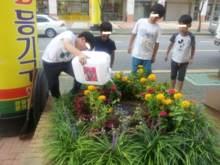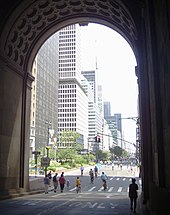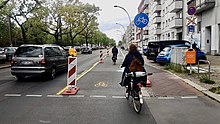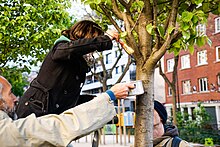
Tactical urbanism, also commonly referred to as guerrilla urbanism, pop-up urbanism, city repair, D.I.Y. urbanism, planning-by-doing, urban acupuncture, and urban prototyping, is a low-cost, temporary change to the built environment, usually in cities, intended to improve local neighbourhoods and city gathering places.
Tactical urbanism is often citizen-led but can also be initiated by government entities. Community-led temporary installations are often intended to pressure government agencies into installing a more permanent or expensive version of the improvement.

Terminology

The term was popularized around 2010 to refer to a range of existing techniques. The Street Plans Collaborative defines "tactical urbanism" as an approach to urban change that features the following five characteristics:
- A deliberate, phased approach to instigating change;
- The offering of local solutions for local planning challenges;
- Short-term commitment as a first step towards longer-term change;
- Lower-risk, with potentially high rewards; and
- The development of social capital between citizens and the building of organizational capacity between public and private institutions, non-profits, and their constituents.
While the 1984 English translation of The Practice of Everyday Life by French author Michel de Certeau used the term tactical urbanism, this was in reference to events occurring in Paris in 1968; the "tactical urbanism" that Certeau described was in opposition to "strategic urbanism", which modern concepts of tactical urbanism tend not to distinguish. The modern sense of the term is attributed to New York-based urban planner Mike Lydon.
The Project for Public Spaces uses the phrase "Lighter, Quicker, Cheaper", coined by urban designer Eric Reynolds, to describe the same basic approach expressed by tactical urbanism.
Origin

The tactical urbanist movement takes inspiration from urban experiments including Ciclovía, Paris-Plages, and the introduction of plazas and pedestrian malls in New York City during the tenure of Janette Sadik-Khan as Commissioner of the New York City Department of Transportation.
Tactical urbanism formally emerged as a movement following a meeting of the Next Generation of New Urbanist (CNU NextGen) group in November 2010 in New Orleans. A driving force of the movement is to put the onus back on individuals to take personal responsibility in creating sustainable buildings, streets, neighborhoods, and cities. Following the meeting, an open-source project called Tactical Urbanism: Short TermAction | Long Term Change was developed by a group from NextGen to define tactical urbanism and to promote various interventions to improve urban design and promote positive change in neighbourhoods and communities.
Examples
Honolulu, Hawaii has some of the highest pedestrian fatality rates in the United States (Wong 2012). Many of their busiest intersections reflect city standards from years past without modification as the quantity of vehicular traffic and associated speeds have changed dramatically. Some residents chose to take a stand in 2014. Within the crosswalk of one of these busy intersections, residents altered the crosswalk lines so that they spelled out "Aloha," the traditional Hawaiian salutation. While the perpetrators sought to introduce a level of humanity to the dangerous location, city officials stated that the change was a "deviation from the standard."
In spring of 2016, the city of Chicago posted unique "no right turn" signage to an intersection. To call attention to this new condition, an unknown person installed two small planter boxes within the crosswalk with flowering plants. Many responded positively while local businesses expressed concern for the traffic pattern change and its effect on their business.
Types of interventions

Tactical urbanism projects vary significantly in scope, size, budget, legality, and support. Projects often begin as grassroots interventions and spread to other cities, and are in some cases later adopted by municipal governments as best practices. Some common interventions are listed below:
Improving public spaces

- Better block initiatives: Temporarily transforming retail streets using cheap or donated materials and volunteers. Spaces are transformed by introducing food carts, sidewalk tables, temporary bike lanes and narrowing of streets;
- Chair bombing: The act of removing salvageable materials and using it to build public seating. The chairs are placed in areas that either are quiet or lack comfortable places to sit.
- Food carts/trucks: Food carts and trucks are used to attract people to underused public spaces and offer small business opportunities for entrepreneurs;
- Open streets: To temporarily provide safe spaces for walking, bicycling, skating, and social activities; promote local economic development; and raise awareness about the impact of cars in urban spaces. "Open Streets" is an anglicized term for the South American 'Ciclovia', which originated in Bogota
- Park(ing) Day: An annual event where on street parking is converted into park-like spaces. Park(ing) Day was launched in 2005 by Rebar art and design studio;
- Pavement To Plazas: Popularized in New York City, Pavement to Plazas involve converting space on streets to usable public space. The closure of Times Square to vehicular traffic, and its low-cost conversion to a pedestrian plaza, is a primary example of a pavement plaza;
- Pop-up cafes: Temporary patios or terraces built in parking spots to provide overflow seating for a nearby cafe or for passersby. Most common in cities where sidewalks are narrow and where there otherwise is not room for outdoor sitting or eating areas;
- Pop-up parks: Temporary or permanent transformations of underused spaces into community gathering areas through beautification;
- Pop-up retail: Temporary retail stores that are set up in vacant stores or property.
Infrastructure

- Crosswalk painting: Guerrilla crosswalks are zebra crossings painted by the community on roadways and at intersections where the city government has failed to provide a marked pedestrian crossing;
- Practical walkways: Desire paths are footpaths or other paths that form via natural use rather than paths designed for use by humans in urban environments. Some of these paths are later improved or paved to offer a more practical route to a particular destination.
- Protected bike lanes: Pop-up bicycle lanes are usually done by placing potted plants or other physical barriers to make painted bike lanes feel safer. Sometimes there is no pre-existing bike lane, and the physical protection is the only delineator.
Removal
- De-fencing: The act of removing unnecessary fences to break down barriers between neighbours, beautify communities, and encourage community building;
- Depaving: The act of removing unnecessary pavement to transform driveways and parking into green space so that rainwater can be absorbed and neighbourhoods beautified;
- Sabotaging hostile architecture: The act of obstructing, defacing, or removing hostile architecture, usually anti-homeless spikes or armrests, to undermine their intended effects, often to protest anti-homelessness legislation. These actions in particular are often considered acts of vandalism.
Nature

- Guerrilla gardening: Cultivating land that the gardeners do not have the legal rights to utilize, such as abandoned sites, areas not being cared for, or private property;
- Guerrilla grafting: Grafting fruitbearing branches onto sterile street trees to make an edible city.
See also
References
- ^ Lydon, Mike; Bartman, Dan; Garcia, Tony; Preston, Russ; Woudstra, Ronald (March 2012). Tactical Urbanism Short-term Action Long-term Change Volume 2. The Street Plans Collaborative. p. 7. Retrieved 23 October 2014.
- Lydon, Mike; Garcia, Tony (December 2016). Tactical Urbanism Materials and Design Guide. Street Plans Collaborative. p. 11. Retrieved 2021-10-19.
{{cite book}}:|website=ignored (help) - Pfeifer, Laura. "The Planner's Guide to Tactical Urbanism" (PDF). Regina Urban Ecology. Retrieved 23 October 2014.
- ^ Mittendorf, Robert (May 29, 2022). "Bellingham neighbors wanted quick action to stop speeding. So they went rogue". The Bellingham Herald. Bellingham, Washington. Retrieved May 29, 2022.
As Bellingham elected officials and traffic engineers are deciding where to prioritize transportation projects such as roads, bike lanes and sidewalks over the next several years, some residents are seeking a speedier remedy. They're trying to goose the bureaucracy into taking quick action to slow the commuters ... To get the city's attention earlier this year, about 50 Columbia residents spent a few hours building a pair of DIY crosswalks, using colored chalk and some traffic cones, materials that cost about $200
- Certeau, Michel de. The Practice of Everyday Life. University of California Press. Reprint edition (December 1, 2011).
- "Tactical Urbanists Are Improving Cities, One Rogue Fix at a Time". Smithsonian.
- "Lighter, Quicker, Cheaper: A Low-Cost, High-Impact Approach". pps.org.
- Bossart, Diane (11 August 2014). "The rise of tactical urbanism". Next Pittsburg. Retrieved 23 October 2014.
- Davis, Brian. "On Broadway, Tactical Urbanism". faslanyc. Retrieved 23 October 2014.
- Lydon, Mike. "The Next Urbanism: A Movement Evolves". Planetizen. Retrieved 23 October 2014.
- Nathaniel M. Hood (12 February 2014). "Don't be stupid. Be flexible". StrongTowns blog. Archived from the original on 6 August 2016.
- Greenfield, John (April 21, 2016). "Eyes on the Street: Tactical Urbanism Blooms on Broadway". StreetsBlog Chicago.
- "The Better Block". The Better Block. Retrieved 23 October 2014.
- "chair bombing - popupinfrastructure". cargocollective.com. Retrieved 2024-04-26.
- Best, Hilary (16 September 2011). "Park(ing) Day!". Spacing Toronto. Retrieved 23 October 2014.
- "Wikispaces". streetswiki.wikispaces.com. Retrieved 2020-04-29.
- "NYC DOT - NYC Plaza Program Sites". nyc.gov.
- Durkin, Erin (23 December 2013). "Bloomberg predicts Times Square pedestrian plaza will stay under de Blasio". nydailynews.com. Retrieved 2020-04-29.
- Kroman, David (May 26, 2022). "Seattle residents painted their own crosswalk. It didn't go over well". The Seattle Times. Seattle. Retrieved May 26, 2022.
There's a name for when community members make unsanctioned changes to city-owned streets: "tactical urbanism."
- "Downtown De-Fence Project". Downtown De-Fence Project. Toronto Building Space Committee. Archived from the original on 23 January 2016. Retrieved 23 October 2014.
- "Why Depave". Depave. Retrieved 11 October 2017.
- MacNeill, Arianna. "'Hostile architecture': A group wanted for removing armrests from MBTA benches says they're helping the homeless". www.boston.com. Retrieved 2024-04-26.
- "Victory As Tesco Abandons Anti-Homeless Spikes After Concrete Vandalism". HuffPost UK. 2014-06-12. Retrieved 2024-04-26.
Further reading
- The Street Plans Collaborative, Inc. (dba Street Plans) in collaboration with Ciudad Emergente and Codesign studio, produces a series of free tactical urbanism e-books. Volumes 1 and 2 focus on North American case studies, Volume 3 is a Spanish-language guide to Latin American projects, and Volume 4 covers Australia and New Zealand, including responses to the 2011 Christchurch earthquake.
- Street Plans' Mike Lydon and Anthony Garcia published a tactical urbanism book in March 2015.
- "Tactical Urbanism". Island Press. Retrieved 23 October 2014.